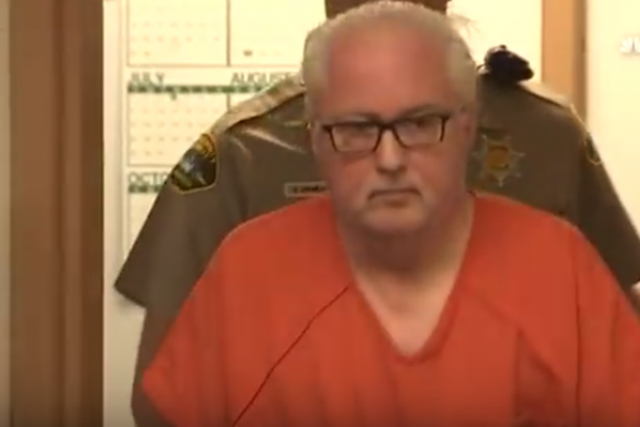DNA Evidence and Genealogy used to Crack 5 More “Cold Cases”
DNA-profiling is evolving into an effective crime-solving technology

Legal Insurrection readers will recall our report on 72-year old Joseph James DeAngelo, the former cop who has been accused of being the “Golden State Killer”. DNA collected from relatives for analysis was used to track down the suspect in a string of 12 murders and 51 rapes.
The technique has been used again, as DNA collected from a napkin was used to locate who authorities believe is a suspect in the 1986 rape and murder of a 12-year-old Washington state girl.
Gary Hartman will be arraigned Monday following his June 20 arrest on charges of first-degree murder and first-degree rape in the 1986 cold case killing of Michella Welch, authorities said.
Tacoma Police Chief Donald Ramsdell called the case a “great example” of “advancements in DNA identification and computer modeling combined with tried and true police techniques.”
… In 2006, a DNA profile was developed from the original crime scene, but there was no match in databases, according to a statement from the prosecutor’s office.
Twelve years later, Tacoma Police detectives worked with genetic genealogists who used DNA technology to track the unknown suspect’s family members, Pierce County Prosecutor Mark Lindquist said in a recent statement. Investigators then incorporated traditional genealogy to make a family tree from information on public websites, according to the statement.
That allowed police to identify two brothers — who lived in the area in 1986 — as possible suspects, Ramsdell said.
This approach has been used to find suspects in the 1992 slaying of Christy Mirack, a 25-year-old teacher, who was wrapping Christmas gifts when someone entered her Pennsylvania home to rape and strangled her; the 1981 killing of Virginia Freeman, a 40-year-old Texas realtor who went to meet a potential buyer and was later found strangled and stabbed, and the identity of a unknown man who committed suicide in 2001.
The catching of the suspected killer of a Canadian couple serves as an example of how the pieces of evidence come together.
The victims: In 1987, Jay Cook, 20, and Tanya Van Cuylenborg, 18, were brutally killed while vacationing in Washington State.
The suspect: William Earl Talbott II, 55, of Seatac, Wash., was arrested in May and charged with murder, and pleaded not guilty.
The path from cousins to suspect: After finding second cousins on GEDMatch, Ms. Moore, built out a family tree all the way back to those individuals’ great-grandparents and then forward to two descendants who tied the two families together.
The couple identified in the genealogical research had just one son, Mr. Talbott, who would have been 24 at time of the murders. His parents’ home was about seven miles from where Mr. Cook’s body was found.
After surveilling Mr. Talbott for several days, detectives collected DNA from a cup he discarded, which matched the DNA extracted from semen at the scene.
Indian inventor Arvind Gupta once said, “Biology is the most powerful technology ever created.” DNA-profiling certainly seems to be evolving into the best crime-solving technology.
Unidentified criminals better start hoping that their relatives, both close and distant, have no interest in learning if they were Scottish, Italian, or Cherokee.
 DONATE
DONATE
Donations tax deductible
to the full extent allowed by law.








Comments
Color me cynical but does anyone think the databases of DNA testing companies (e.g. 23 and me) would/could ever be used in a different way, i.e. to match DNA of a crime?
EZ Pass has been used in court to prove someone was not where they say they were.
I’m still expecting my health care company to ask me why I buy Klondike ice cream bars (with my supermarket Rewards card) since my cholesterol is high
I *did* read that the DNA was obtained by a discarded napkin.
I’m just thinking of other applications. Who would’ve thot Facebook et al would sell our personal data?
“Who would’ve thot Facebook et al would sell our personal data?”
See CalFed comment below…
Phones are cheap because the companies sell everything. We love big brother.
You know what they say…If you are not paying for the product, then you are the product
They’ll eventually find obama’s DNA on Larry Sinclar’s groin:
https://www.vice.com/sv/article/5gavex/this-man-has-proof-that-obama-is-gay
Now we know the real reason Liz Warren doesn’t want to do the test!
Most of the outraged expressed in the legal community about DNA use is from criminal defense attorneys who see this as a huge impediment to getting their guilty client off.
I don’t have any objection to this. People are free to share their DNA information with anyone they like, and if it provides a clue that convicts a criminal who happens to be a relative, no one’s rights have been violated in even the slightest degree. It’s really no different than if the criminal accidentally dropped his cousin’s business card at the crime scene and was tracked down that way. It’s certainly not the same as if anyone was forced to give up their own DNA without probable cause.
While there is nothing inherently wrong with this method of identifying criminals, there are inherent problems with basic privacy issues. And, that is what the courts are going to have to ultimately address here.
What we have, in these cases, is government trolling private DNA databases to attempt to find partial or exact matches to DNA samples found at crime scenes, without having identified any potential suspect in the crime. The question then becomes, what is the degree of legal privacy which is expected to exist for those who present DNA samples to these companies for specific genealogical uses.
They’re public databases– specifically set up, and required to be actively opted *into*, for the purpose of finding other matches.
Not a database of all the samples sent to the company.
Every yin has a yang.